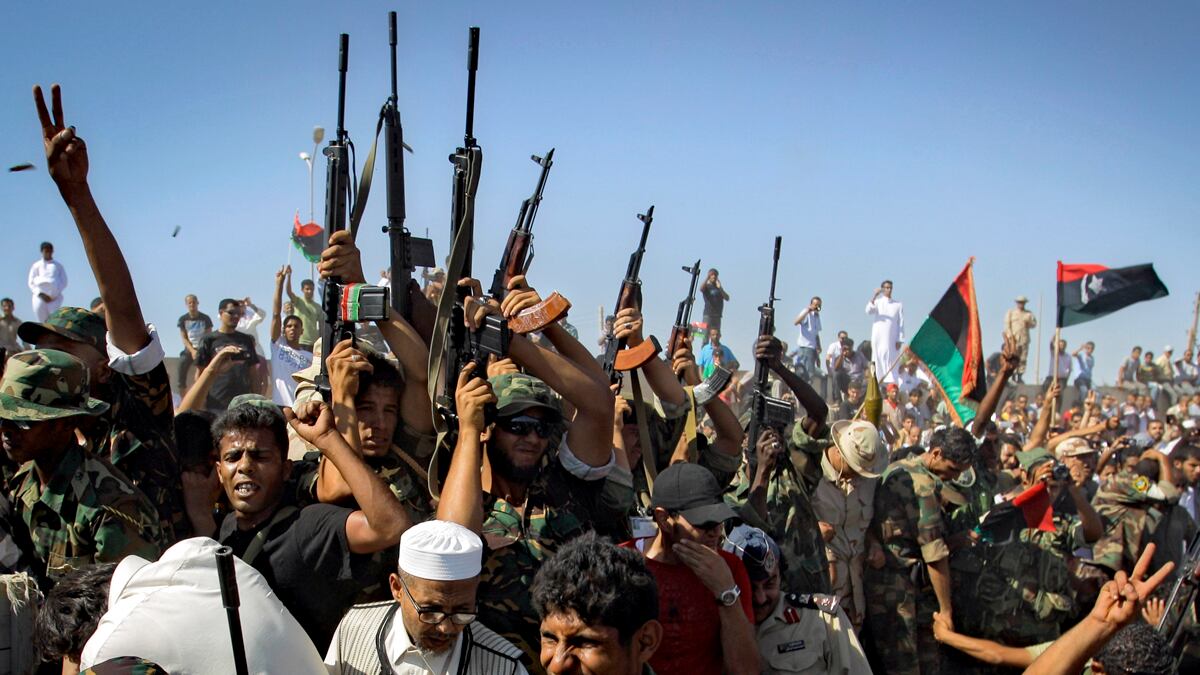With the Libyan revolution winding down and armed conflict expected soon to be over, the rebel government, the United Nations, and the international community face a new headache: what to do with the huge amount of weapons floating around the country.
From assault rifles to antiaircraft missiles, Libya is overflowing with armaments. Neighboring countries fear the spread of these weapons into their own borders, where they may be used by militant groups such as Al Qaeda. Meanwhile Libya, with its checkered tribal history, might have a problem with armed young men in the streets. Though Libya’s transitional government is putting together a program to reclaim its fighters’ guns and explosives, the program is in its early stages and its success remains to be measured.
“Proliferation of weapons is a major concern,” Ian Martin, the U.N.’s special adviser on Libya, was quoted as saying.
The weapons come from many directions. Libya’s National Transitional Council distributed guns among its fighting groups during the conflict. Other pro-revolution fighters bought rifles with their own money, and still others raided them from Gaddafi’s storehouses as they took over the his supply lines in the push towards the capital. The heaviest weapons, such as antiaircraft and antitank missiles, came from around the capital itself.
“Due to NATO attacks, [pro-Gaddafi troops] moved weapons to homes and farms around Tripoli,” said Fred Abrahams, a researcher with Human Rights Watch. “When they fled, these caches were up for pickings.”
In the days following the fall of Tripoli, groups of rebels dug through the ruins of Bab el-Aziziya, unearthing crates of assault rifles, machine guns, and vehicle-mounted weapons. Massive caches were found near the prison of the capital’s Abu Salem district and several locations south of Tripoli.

According to Human Rights Watch’s findings, the rebel armed forces have secured most of the heavier weapons and placed them under guard. However, it remains impossible to tell how many are still missing throughout the country. The country is also awash with small arms.
“This is a Beretta. It’s good,” a rebel fighter who identified himself as Hassan said, displaying his gun outside Bab el-Aziziya before he took aim and shot out the glass from a broken street light overhead.
A major concern of the U.N., as well as countries neighboring Libya, is that some of these weapons will be sold outside of the country, much like what happened in Iraq. Some of these guns may find their way into the hands of al Qaeda and other militant groups. “It’s a concern to Libya’s neighbors, quite naturally,” said the U.N.’s Martin.
Abdelkader Messahel, an Algerian foreign minister, said that Al Qaeda fighters are “reinforcing themselves with arms coming from Libya,” during an African Union summit in July. An Algerian newspaper, El Khabar, reported that arms dealers attempted to smuggle 218 pieces of weapons into Algeria in July. Alfredo Perez Rubalcaba, Spain’s interior minister, confirmed that this equipment might be falling into Al Qaeda’s hands.
“There are justifiable concerns that range from the transport of weapons to regional neighbors, potentially fueling existing militant violence and, for some, furthering instability, to the appearance of Libyan weapons on the broader black market,” said Kimberly Jones, the associate director of the international affairs program at the Middle East Center for Peace, Culture and Development. “Intergovernmental organizations will not see national or regional security as a cost they are willing to pay to empower the Libyans if progress toward this goal is insufficient or slow.”
But weapons are just as dangerous inside Libya. The National Transitional Council has so far managed to keep its forces united against a common enemy, but plenty of Libyans are unsure where the armed men will aim now that Gaddafi is out of the picture.
“Another issue with the Libyan crisis is the sheer diversity of the country in every conceivable meaning of the term. It is highly fragmented ethnically, regionally, and by the distribution of wealth. Add to that, 42 years of oppressive rule in which some families and tribes bore the brunt of the governments’ oppressive practices, you have the seeds for revenge and disaster already sewn and only waiting to explode,” said Moses Tesi, professor of political science at Middle Tennessee State University.
“Every second Libyan has at least a Kalashnikov. In the long term, decommissioning these weapons is critical,” Human Rights Watch’s Abrahams added.
Libya’s National Transitional Council said that it is putting together a task force to collect weapons from the various fighters and place them under the control of an official police force and a new Libyan Army. These will be collected in mosques, in exchange for monetary compensation.
Hisham Khalef, a volunteer fighter who mans a checkpoint in Tripoli’s Souk Juma neighborhood, said that the weapons will be given back as soon as the order is restored. “The Army will give people 3,000 dinars and people will be happy to give them up,” he said.
With Libya facing money shortages and some African countries still blocking the unfreezing of Libyan funds, it is uncertain when this is going to happen quickly. At the same time, with a few cities in Libya still defiant against the NTC, the country is still in a state of war, and the collection program may not occur until these are captured and secured. Then there is the issue of getting people to give up their most dependable tools in the six-month conflict.
“The NTC is, in many ways, starting from scratch in terms of state authority and governance. Many Libyan watchers say Gaddafi was the state, so creating a new government will take time,” said Jones.






